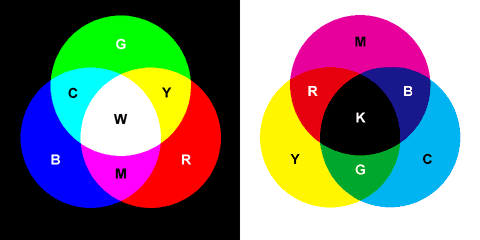Three primary colors
Additive primaries
Natural light includes various wavelengths.
The "cone" cell of photoreceptors in the retina of human eyes has pigments that are sensitive to red, green, and blue lights, respectively, and the brain feels the proportion of these three stimuli as color.
Therefore, it is reasonable to assume that the color can be expressed by superimposing light of three primary colors on a dark screen (black) where no light is applied.
The left figure shows how adding lights of primary colors results in.
To the human eye, R+G look yellow, G+B look light blue (cyan), and B+R look dark pink (magenta).
When three colors are mixed (R+G+B), they look white.
Computers and televisions reproduce colors in this manner.
Subtractive primaries
On the other hand, subtractive mixing (right) takes place when ink or color filters are overlaid on a white background containing R+G+B lights.
It will be helpful to consider cyan (C) as a red cut filter, magenta (M) as a green cut filter, and yellow (Y) as a blue cut filter.
These CMY primaries are used for colors of ink.
If ideal CMY inks exist, CMY colors will be the complementary colors of RGB, respectively, and the subtractive mixture gives exactly the complementary colors of those by the additive mixture.+
In reality, CMY colors look a little different from the complementary colors of RGB.
Also, when CMY inks are overlaid, not all colors can be cut completely, so the color will not be deep black.
For this reason, black (K) ink is used supplementarily in printing.
Here K stands for Key plate.
Symbol
|
Color
|
R
|
Red
|
G
|
Green
|
B
|
Blue
|
C
|
Cyan
|
M
|
Magenta
|
Y
|
Yellow
|
W
|
White
|
K
|
Key
|
[Reference] - LCD screen
Magnifying an LCD screen or a TV screen, we can see that the colors are reproduced by mixing RGB colors
(see photos below).
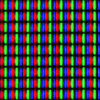
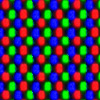 LCD (left) and TV (right)
LCD (left) and TV (right)
[Reference] - Human vision
Many animals have four or more primary colors.
For example, insects can see ultraviolet light well.
Even vertebrates, most reptiles and birds have four primary colors.
However, many mammals feel only two primary colors.
Because mammals were nocturnal, the cones having color vision seemed to have degenerated and instead developed rods that feel weak light.
Of the mammals, only old world monkeys have the three primary colors.
It is thought that tens of millions of years ago the green cones were obtained by slightly changing the pigment properties of the red cones, so that they turned to the cones for the third primary color.
For this reason, the absorption wavelength of human green pigment and that of human red pigments are relatively close to each other.
The imperfect red or green color vision, a so-called color blindness, appears in men at a few percent rate may be due to the genetically new separation of red and green color vision.
(Since the genes that make the red and green pigments are on the X chromosome, color blindness is more likely to appear in men who have only one X chromosome.)
Incidentally, S, M, and L in the figure represent the absorbances of the pigments of the S (Short wavelength) cone, the M (Medium wavelength) cone, and the L (Long wavelength) cone, respectively.
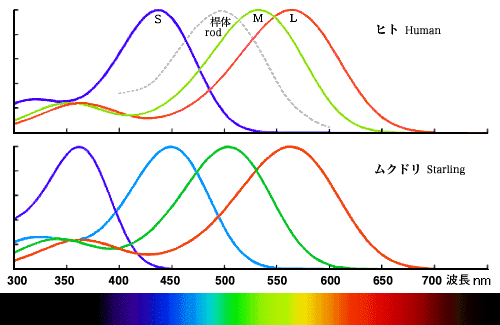 Absorption curves of pigments from humans and birds (starlings).
Human blue corresponds to bird purple, human green and red correspond to bird red.
Absorption curves of pigments from humans and birds (starlings).
Human blue corresponds to bird purple, human green and red correspond to bird red.
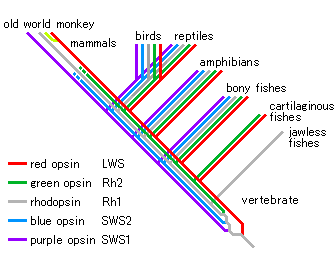 Evolution of color vision.
Mammals lost two color visions, but only nasal monkeys regained their "green" color vision.
Rhodopsin (from "rod") is a night vision pigment.
Evolution of color vision.
Mammals lost two color visions, but only nasal monkeys regained their "green" color vision.
Rhodopsin (from "rod") is a night vision pigment.
Back
T. Fujiwara
